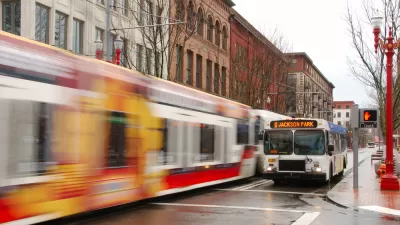Downloading my newest addition to my Kindle library—the digital book service provided by Amazon.com—I remembered the gentle criticism of a planner on a list serve not too long ago. The thread was on sustainability and global warming. I had made the point that market economies were innovative economies, and too much of the planning discussion on sustainability focused on reduced consumption without seriously discussing the ways technology fundamentally changed our choice sets. The planner chastised me for my faith in markets, saying, in a nutshell, we need to focus on what we know we can influence and not hedge are bets on the past. The implication was that markets were too ephemeral and undependable to include in long-term planning.
Downloading my newest addition to my Kindle library-the digital book service provided by Amazon.com-I remembered the gentle criticism of a planner on a list serve not too long ago. The thread was on sustainability and global warming. I had made the point that market economies were innovative economies, and too much of the planning discussion on sustainability focused on reduced consumption without seriously discussing the ways technology fundamentally changed our choice sets. The planner chastised me for my faith in markets, saying, in a nutshell, we need to focus on what we know we can influence and not hedge are bets on the past. The implication was that markets were too ephemeral and undependable to include in long-term planning.
At the time I was struck by the ahistorical nature of the point. The argument was that our historical ability to innovate our way out of problems of the past doesn't mean we can rely on innovation to achieve the same impact now. That's a fair point. Nothing guarantees the future. But, it also ignores five centuries of human progress. Indeed, the best predictor of the future is the past. This principle is imbedded in virtually every data point used in the planning process, from demographic projections to economic ones to forecasting the built environment.
The more relevant point, however, is not that the innovation won't occur, but what institutions are necessary to allow innovation to continue. [I discuss this in more depth in two articles, one in Town Planning Review (vol. 77, no. 1, 2006) and the other in Property Management vol 24, no. 3, 2006).] Planning can have very important impacts on the institutions necessary for sustaining innovation. If planning cuts off the incentives and pathways for innovation, then societies decline, both in standard of living as well as quality of life.
On this point, the role of private markets can't be dismissed. Markets provide an institutional mechanism for promoting innovation. No other public or private institution-cultural, economic, or political-can match (or has matched) the "creative destruction" of market economies. And that, in my view, is a beneficial outcome for societies, communities, and cities. Innovation is what allows us to replace wood with coal, coal with oil, and, more importantly for current environmental problems, oil and coal with nuclear power, all while using fewer resources (most clearly on a per capita basis and often in absolute terms as well).
This brings me back to my Kindle. As I pull books from my book shelves and load up them up in boxes to donate them to the local library, I recognize the revolutionary (and environmentally friendly) impact of this new gadget. I will be able to achieve all my book needs in a smaller space and consume fewer resources.
And I'm not alone. On Christmas Day 2009, Amazon.com sold more Kindle books than regular print books for the first time ever industry watchers think about 500,000 units were shipped during 2009. In the process, Amazon.com is achieving something few people that possible a few years ago: They are making digital formats a consumer substitute for hard copy versions of books.
The environmental implications are significant. As digital formats take even broader hold in the economy, print publications will largely disappear for the most popular books, recessing to niche markets such as graphics intensive coffee table books. The demand for paper, and paper processing, will plummet as the need for all the inks and dyes necessary for printing book covers and the physical printed word fades. Consumers will need less space to store wall-consuming bookshelves. We will have more, but be able to live with less. Digital formats are also cheaper (Kindle books sell for half the retail price of a hard copy, and sometimes more), making reading even more accessible.
While we were certainly will lose something in the aesthetics of place and life (I still enjoy the feel of a book in my hands), in my mind the innovation unleashed by the intrepidness of the inventors at amazon.com and their suppliers is unquestionably progress, for the economy, society and the environment.
This innovation, like the vast majority of innovations, was not planned; it was a spontaneous product of the private market searching for new ways to meet consumer needs (while making money at the same time). More importantly, the Kindle is a metaphor for the kind of innovation that is necessary for achieving meaningful sustainable development in a dynamic context. These innovations allow us to move forward on the Environmental Kuznets Curve, where higher incomes allow societies to adopt more environmentally friendly technologies. (Matthew Kahn discusses this extensively in his highly readable book Green Cities.)
As planners grapple with the real world problems of sustainable development, they will need to figure out ways to sustain this kind of innovation on small (e.g. kindle) and large (e.g., nuclear power) scales. This means embracing the only social institution capable of providing the incentives and forward momentum possible to achieve it: the private market. Unfortunately, I've seen little of this in the formal planning process let alone the dialogue among professional planners.
Innovation, and the private market that sustains it, is not mystical, mythical or emphemeral. It is real and long-term, as long as we provide the institutions necessary to nurture it.

Maui's Vacation Rental Debate Turns Ugly
Verbal attacks, misinformation campaigns and fistfights plague a high-stakes debate to convert thousands of vacation rentals into long-term housing.

Planetizen Federal Action Tracker
A weekly monitor of how Trump’s orders and actions are impacting planners and planning in America.

In Urban Planning, AI Prompting Could be the New Design Thinking
Creativity has long been key to great urban design. What if we see AI as our new creative partner?

King County Supportive Housing Program Offers Hope for Unhoused Residents
The county is taking a ‘Housing First’ approach that prioritizes getting people into housing, then offering wraparound supportive services.

Researchers Use AI to Get Clearer Picture of US Housing
Analysts are using artificial intelligence to supercharge their research by allowing them to comb through data faster. Though these AI tools can be error prone, they save time and housing researchers are optimistic about the future.

Making Shared Micromobility More Inclusive
Cities and shared mobility system operators can do more to include people with disabilities in planning and operations, per a new report.
Urban Design for Planners 1: Software Tools
This six-course series explores essential urban design concepts using open source software and equips planners with the tools they need to participate fully in the urban design process.
Planning for Universal Design
Learn the tools for implementing Universal Design in planning regulations.
planning NEXT
Appalachian Highlands Housing Partners
Mpact (founded as Rail~Volution)
City of Camden Redevelopment Agency
City of Astoria
City of Portland
City of Laramie






























